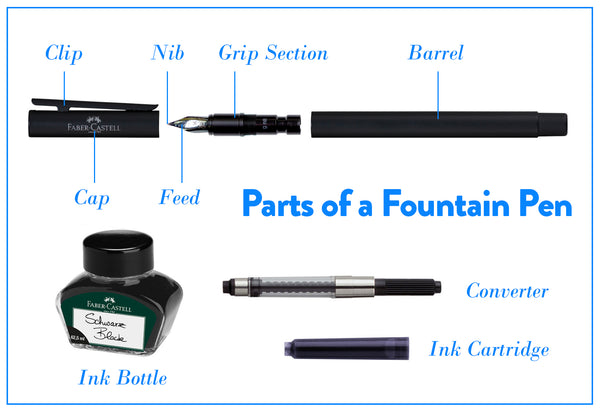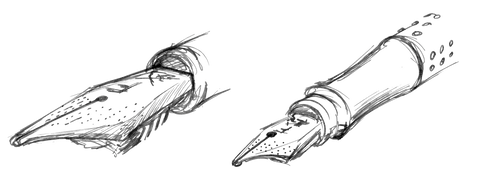Fountain Pen 101: The Basics of Fountain Pens

Fountain pens are a classic writing staple, but truly understanding their unique qualities or how to properly use one can be confusing. In today’s modern world, much of human communication is digitized. Despite this constant evolution in the way we humans communicate, these unique qualities of fountain pens have helped the instrument withstand the test of time. Fountain pens can be used for everyday writing and are used as a preferred writing instrument in many countries. When choosing a fountain pen, it is important to understand that fountain pens are personal to each user and understanding them better will help you make the right choice in the pen you choose.
The essential nature of writing with a fountain pen is that wet ink is fed to a chisel point by capillarity. Fountain pens are different than other pens by the fact that they have a nib instead of a ball.
The make of a fountain pen consists of the barrel, rib section, feed, and nib. The barrel contains a reservoir of ink that flows to the nib through the feed.

Faber-Castell reservoirs are either disposable cartridges or a refillable converter. Some pens use a twist siphon mechanism. The feed consists of a series of baffles and fins that control the flow of ink to the nib. The flow is controlled by adjusting the nib and feed in the section. Last, nibs are made from a variety of materials including steel and gold and come in a range of widths. The narrower the nib, the less ink the pen lays down on the paper.
When using a fountain pen, hold the nib downwards to prevent leaking. Once the nib touches the writing surface, the ink will flow. Be sure to glide both sides of the nib consistently across the paper, or the ink will not write smoothly. It is also important to not press down too hard as skipping may occur when applying too much pressure.

As previously mentioned, fountain pens are personal. Once you begin using the pen, the nib will begin to take shape based on your writing style. If your handwriting is small and tight, an extra-fine or fine nib may be the best choice. If your handwriting is large and fast, or you’re looking for a signature pen, broad may be more to your liking. Medium nibs are the most common, but special nibs are also available for those interested in calligraphy.
Faber-Castell provides a range of fountain pens of different styles. Explore our Fine Writing, General Writing, and our Graf von Faber-Castell luxury writing collections to find the best fountain pen for you.

